trans-Cinnamamide/(2E)-3-Phenyl-2-propenamide |
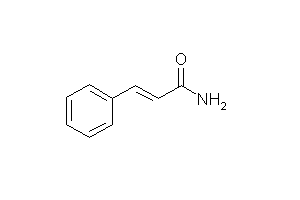 |
| Name | trans-Cinnamamide | |
| Synonyms | (2E)-3-Phenyl-2-propenamide | |
| Name in Chemical Abstracts | 2-Propenamide, 3-phenyl-, (2E)- | |
| CAS No | 22031-64-7 | |
| EINECS No | ||
| Molecular formula | C9H9NO | |
| Molecular mass | 147.18 | |
| SMILES code | NC(=O)/C=C/c1ccccc1 | |
1H NMR
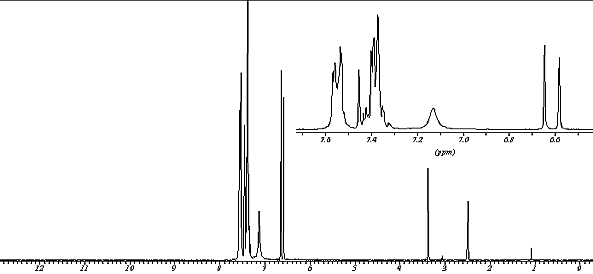
| 1H-NMR: trans-Cinnamamide | |||
| 250 MHz, DMSO-d6 | |||
| delta [ppm] | mult. | atoms | assignment |
| 6.61 | d (JAB= 15.9) | 1 H | C=CH-CO (2-H) |
| 7.13 | broad s | 1 H | NH |
| 7.2-7.6 | m | 7 H | CH (arom.) + NH + -CH=C (3-H) |
| 7.42 | d (JAB= 15.9) | 1 H | -CH=C (3-H) |
| 6.53 | d | 1 H | C=CH-CO (2-H, cinnamic acid) |
| 7.82 | d | 1 H | -CH=C (3-H, cinnamic acid) |
| 2.5 | s | DMSO | |
| 3.33 | s | O-CH3 (tBu-OMe) | |
| 1.19 | s | C-CH3 (tBu-OMe) | |
13C-NMR |

| 13C-NMR: trans-Cinnamamide | |||
| 250 MHz, DMSO-d6 | |||
| delta [ppm] | assignment | ||
| 122.31 | C2 (=CH-) | ||
| 127.52 | CH arom. | ||
| 128.90 | CH arom. | ||
| 129.42 | C4 (arom.) | ||
| 134.86 | C quart. arom. | ||
| 139.16 | C3 (-CH=C) | ||
| 166.68 | C1 (-C(=O)NH2) | ||
| 38.5-40.5 | DMSO-d6 | ||
IR |

| IR: trans-Cinnamamide | |||
| [KBr, T%, cm-1] | |||
| [cm-1] | assignment | ||
| 3375, 3175 | N-H valence | ||
| 3084 | aliph. C-H valence, =C-H | ||
| 1665 | C=O valence, carboxamide | ||
| 1610 | alkene C=C valence | ||
| 1580, 1495 | arom. C=C valence | ||
Chromatogram |
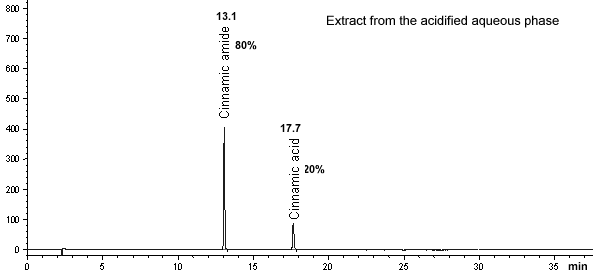
| HPLC: crude product | |
| column | Phenomenex Luna C18; particle diameter 3 µm, L= 150 mm, ID= 4.6 mm |
| column temperature | 25 °C |
| injection | 5 µL |
| mobile phase | 5% MeCN / H2O (0.0059% CF3COOH), gradient to 95% MeCN / H2O (40 min), 10 min isocratic |
| flow | 1.0 mL/min |
| detector (UV 220 nm) | percent concentration calculated from relative peak area |
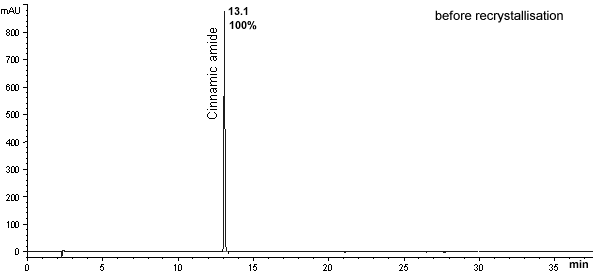
| HPLC: pure product | |
| column | Phenomenex Luna C18, particle diameter 3 µm, Länge 150 mm, Innendurchmesser 4.6 mm |
| column temperature | 25 °C |
| injection | 5 µL |
| mobile phase | 5% MeCN/H2O (0.0059% CF3COOH), gradient to 95% MeCN/H2O (40 min), 10 min isocratic |
| flow | 1.0 mL/min |
| detector (UV 220 nm) | percent concentration calculated from relative peak area |
| Name | trans-Cinnamamide | ||
| Synonyms | (2E)-3-Phenyl-2-propenamide | ||
| Name in Chemical Abstracts | 2-Propenamide, 3-phenyl-, (2E)- | ||
| CAS No | 22031-64-7 | ||
| EINECS No | |||
| Molecular formula | C9H9NO | ||
| Molecular mass | 147.18 | ||
| SMILES code | NC(=O)/C=C/c1ccccc1 | ||
 |
|
 |
+ |  |
IR |

| IR: trans-Cinnamamide | |||
| [KBr, T%, cm-1] | |||
| [cm-1] | assignment | ||
| 3375, 3175 | N-H valence | ||
| 3084 | aliph. C-H valence, =C-H | ||
| 1665 | C=O valence, carboxamide | ||
| 1610 | alkene C=C valence | ||
| 1580, 1495 | arom. C=C valence | ||
 DRUG APPROVALS BY DR ANTHONY MELVIN CRASTO …..FOR BLOG HOME CLICK HERE
DRUG APPROVALS BY DR ANTHONY MELVIN CRASTO …..FOR BLOG HOME CLICK HERE
Denpasar, bali, indonesia
-
Denpasar – Wikipedia, the free encyclopedia
https://en.wikipedia.org/wiki/Denpasar
Denpasar (Indonesian: Kota Denpasar, Indonesian pronunciation: [dənˈpasar]) is the capital and the most populous city of the Indonesian province of Bali.
 .
. Denpasar market, Denpasar is the capital of Bali Province. The main street of Denpasar is Gajah Mada street where is the main shopping center, .
Denpasar market, Denpasar is the capital of Bali Province. The main street of Denpasar is Gajah Mada street where is the main shopping center, .A very giant Ogoh-ogoh at a cross junction in Denpasar

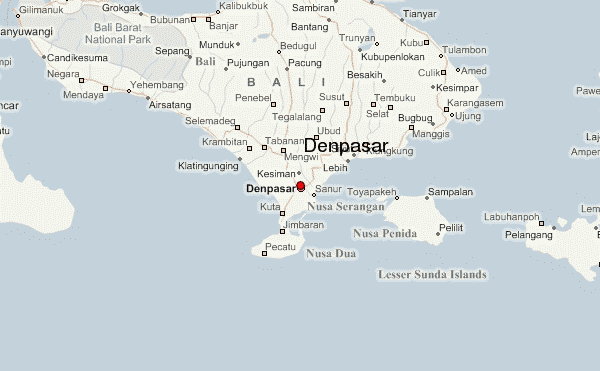
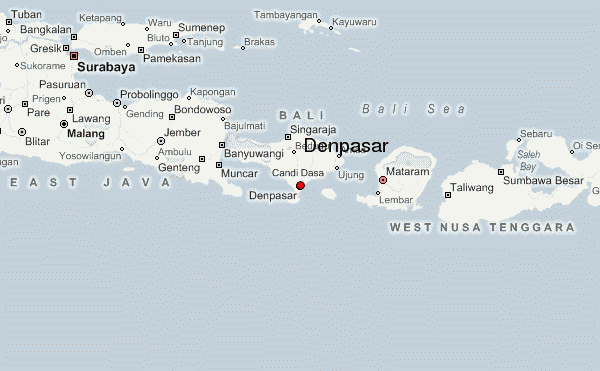
 A view from the Kumbasari Market
A view from the Kumbasari Market



 PT (PERSERO) ANGKASA PURA I CABANG BANDARA NGURAH RAIGEDUNG WISTI SABHA LANTAI 3 BANDARA NGURAH RAIDENPASAR, BALI 80362
PT (PERSERO) ANGKASA PURA I CABANG BANDARA NGURAH RAIGEDUNG WISTI SABHA LANTAI 3 BANDARA NGURAH RAIDENPASAR, BALI 80362Bali Airport (Ngurah Rai) Denpasar – Indonesia
Bali Ngurah Rai International Airport, also known as Denpasar International Airport, is located in southern Bali, 13 km south of Denpasar. It is Indonesia’s third-busiest international airport.
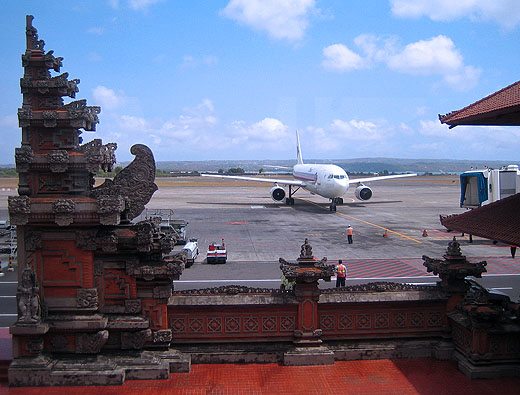
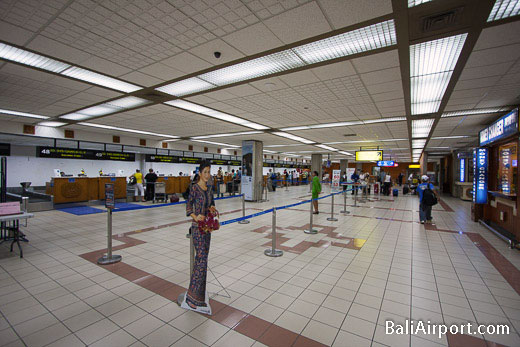
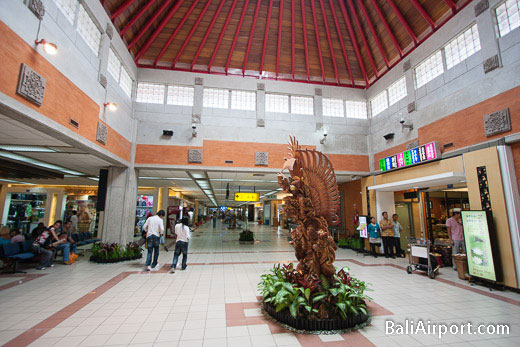

Bajak Laut Nasi Tempong & Seafood, Renon, Bali
Sporting the growth of Denpasar residents’ likes for Nasi Tempong, Bajak Laut Nasi Tempong & Seafood sets on a different kind of path by combining Nasi Tempong with the other well-known Bali’s best: Seafood.
Sets in the cozy neighborhood of Renon, Denpasar, Bajak Laut is the newest addition of restaurant openings in this area. From the down-to-earth food courts selling Ayam Goreng, Chinese food and Sup Kepala Ikan, to the more luxurious XO Suki & Cuisine, Ayucious, or the more established Bendega, Ikan Bakar Cianjur, and Hanamasa, Bajak Laut further marks Renon as a leading Denpasar’s culinary destination.
Though opened really close to the market leader Nasi Tempong Indra, that with its aggressive market expansion in 2012 opens two new branches around Renon area alone, Bajak Laut however has what Indra has not: various choices of seafood comprising of fishes, shellfish, crabs, and shrimps. Therefore market wise, Bajak Laut is aiming at a slightly different crowds: those who loves the spicy Nasi Tempong, and those who loves Seafood; especially those too tired to go through all the traffic madness at Simpang Siur to reach Jimbaran.
(Or believes it’s too touristy.)
As the champion of this premise, Bajak Laut offers “Kepiting Asap ala Bajak Laut”, which are crabs cooked in sweet and savory rubs, then grilled inside banana leaf wraps to enhance its aroma. The result is a treat not only delicious to the taste but also to the sight.
Ingredients used for the rub is dominated with daun salam, or Indonesian bay leaves. For those familiar with gepuk; fried beef first marinated in spices and brown sugar, Kepiting Asap ala Bajak Laut has an almost identical seasoning.
One portion of Kepiting Asap ala Bajak Laut consisting of two crabs weighing total of 5 ons (500 grams). At 120K they’re good for two, while the 7 ons one costs 150K. For the 5 ons portion, the crab size is a bit small, hence eating them requires quite an effort.
Nasi Tempong is a good example how a food originated from outside Bali could becomes a local hit. Originated from Banyuwangi, Nasi Tempong managed to get quite followers due to its main character of super spicy sambal. Nasi Tempong usually served as a package consisting of white rice, steamed vegetables, tahu, tempe, anemic salted fish, and super spicy sambal, and a main dish of either fried chicken, or other kind of proteins.
While I’m not a die-hard spicy food fans, I found their Nasi Tempong quite palatable, especially since the stewed vegetables plus sambal that’s the core of every Nasi Tempong dish, is like a staple food in Western Java where I grew up.
Service is polite and attentive, though we found it’s a bit hard to get attention from the waiters, except from the one stand by the front door. Beside of the seafood, the Nasi Tempong variations are sold around 12K to 45K,
Starting December 2013 but don’t know for how long, Bajak Laut Nasi Tempong & Seafood offers a special discount for their set menu, at 150K for 4 people, and 250K for 6 people.
One annoying condition that we have to face as well, that even though the premise is fully airconed, people are allowed to smoke! And here in Denpasar, Bali, sadly it’s the common case with many eating premises, and Bajak Laut is no exception. Therefore while their crab is quite delicious, until Bajak Laut separates its smoking and non-smoking section it poses health hazard to your youngsters. (byms)
Bajak Laut Nasi Tempong & Seafood
Jl. Cok Agung Tresna No.23, Renon, Denpasar, Bali
(0361) 7984007//////////
Join me on google plus Googleplus
 amcrasto@gmail.com
amcrasto@gmail.com
/////////


















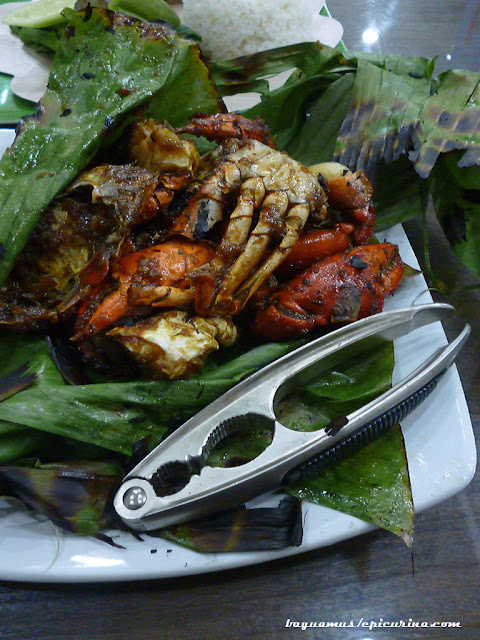


Sorry, the comment form is closed at this time.